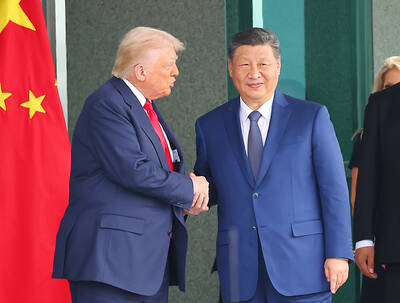Taiwan Semiconductor Manufacturing Co (TSMC, 台積電) yesterday reported that revenue last month expanded 25 percent annually, but fell 12.8 percent month-on-month to NT$105.96 billion (US$3.59 billion).
In the first seven months of this year, the chipmaker’s revenue surged 33.6 percent to NT$727.26 billion, compared with NT$544.46 billion a year earlier.
TSMC has said it aims to grow its revenue by more than 20 percent this year.
The company has since May 15 stopped taking new orders from Huawei Technologies Co (華為), its second-biggest customer after Apple Inc, due to the US’ restrictions on exports containing US technologies.
TSMC has no plans to ship wafers to Huawei after Sept. 14, as Washington has not made a final decision on the matter yet, it said.
Losing Huawei’s orders seemed not an issue for TSMC as its chief executive officer C.C. Wei (魏哲家) told investors last month that he was not worried about filling its 5-nanometer capacity.
Separately yesterday, United Microelectronics Corp (聯電) said that revenue last month grew 12.87 percent annually and 6.24 percent monthly to NT$15.49 billion, a record high.
Its revenue in the first seven months reached NT$102.15, up 24 percent from a year earlier, it said.
Chip designer MediaTek Inc (聯發科) said that revenue last month jumped 29 percent year-on-year and 5.59 percent month-on-month to NT$20.69 billion.
MediaTek is considered a major beneficiary of the US’ ban on Huawei, as it could win new orders from the Chinese technology giant to supply advanced 5G chips after Huawei runs through stockpiles of Kirin chips designed by its semiconductor arm, Hisilicon Technologies Co (海思).
TSMC’s sole supplier of extreme ultraviolet light pods, Gudeng Precision Industrial Co (家登), reported that revenue last month grew 24.13 percent annually to NT$214.59 million, but dropped 33 percent from the previous month.
During the first seven months, cumulative revenue advanced 16.3 percent to NT$1.44 billion from a year earlier, it said.
Gudeng reported earnings per share of NT$1.66 for last quarter, down from NT$1.75 a year earlier, but up from NT$0.15 in the previous quarter.
The firm said it was positive about its business outlook in the second half, as it has increased capacity to satisfy customers’ demand following a production expansion in Tainan.

RUN IT BACK: A succesful first project working with hyperscalers to design chips encouraged MediaTek to start a second project, aiming to hit stride in 2028 MediaTek Inc (聯發科), the world’s biggest smartphone chip supplier, yesterday said it is engaging a second hyperscaler to help design artificial intelligence (AI) accelerators used in data centers following a similar project expected to generate revenue streams soon. The first AI accelerator project is to bring in US$1 billion revenue next year and several billion US dollars more in 2027, MediaTek chief executive officer Rick Tsai (蔡力行) told a virtual investor conference yesterday. The second AI accelerator project is expected to contribute to revenue beginning in 2028, Tsai said. MediaTek yesterday raised its revenue forecast for the global AI accelerator used

TEMPORARY TRUCE: China has made concessions to ease rare earth trade controls, among others, while Washington holds fire on a 100% tariff on all Chinese goods China is effectively suspending implementation of additional export controls on rare earth metals and terminating investigations targeting US companies in the semiconductor supply chain, the White House announced. The White House on Saturday issued a fact sheet outlining some details of the trade pact agreed to earlier in the week by US President Donald Trump and Chinese President Xi Jinping (習近平) that aimed to ease tensions between the world’s two largest economies. Under the deal, China is to issue general licenses valid for exports of rare earths, gallium, germanium, antimony and graphite “for the benefit of US end users and their suppliers

Dutch chipmaker Nexperia BV’s China unit yesterday said that it had established sufficient inventories of finished goods and works-in-progress, and that its supply chain remained secure and stable after its parent halted wafer supplies. The Dutch company suspended supplies of wafers to its Chinese assembly plant a week ago, calling it “a direct consequence of the local management’s recent failure to comply with the agreed contractual payment terms,” Reuters reported on Friday last week. Its China unit called Nexperia’s suspension “unilateral” and “extremely irresponsible,” adding that the Dutch parent’s claim about contractual payment was “misleading and highly deceptive,” according to a statement

Artificial intelligence (AI) giant Nvidia Corp’s most advanced chips would be reserved for US companies and kept out of China and other countries, US President Donald Trump said. During an interview that aired on Sunday on CBS’ 60 Minutes program and in comments to reporters aboard Air Force One, Trump said only US customers should have access to the top-end Blackwell chips offered by Nvidia, the world’s most valuable company by market capitalization. “The most advanced, we will not let anybody have them other than the United States,” he told CBS, echoing remarks made earlier to reporters as he returned to Washington